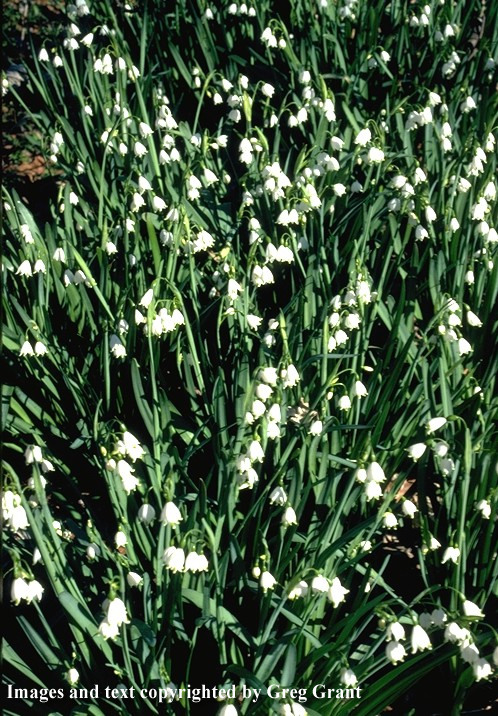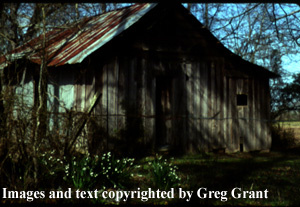Search
For The Answer
Click here to access our database of
Plant Answers
Search
For The Picture
Click here to access the Google database of plants
and insects
Information
Index
Alphabetical Listing of Topics, Recommendations
and Plants
Milberger's Nursery and Landscaping
3920 North Loop 1604 E.
San Antonio, TX 78247
210.497.3760
nursery@milbergersa.com
Open 9 to 6 Mon. through Sat.
and 10 to 5 on Sun.

Three exits east of 281, inside of 1604
Next to the Diamond Shamrock station
Please click map for more detailed map and driving directions.

Snowflakes (Leucojum aestivum)
Greg Grant
Wouldn't it be nice if all plants would grow in sun or shade, wet or dry conditions, and acid as well as alkaline soils? As long as we're dreaming, how about one that never needs dividing, never needs spraying, never needs watering, never needs fertilizing, and lives forever too? And of course it has to be pretty. An ugly plant just won't do. We forgot about universal. Everybody in the state must be able to grow it. It needs to be an "equal opportunity" plant. This is the 90's you know.
Sounds like something out of a Sunday tabloid or the home shopping network's "plant of the week" doesn't it? Guess what? There is such a plant...honest!
Snowflakes, with dainty white flowers above attractive dark green foliage, are among the easiest spring blooming bulbs to grow. Leucojum aestivum, our common snowflake is known in books as the summer snowflake. Ironically it blooms in early spring, generally around late February or early March. The botanical name Leucojum is derived from the Greek leucos (white) and ion (violet). There are also autumn snowflakes (Leucojum autumnale) and spring snowflakes (Leucojum vernum). Neither of these is common and reportedly don't thrive here. The violet scented spring snowflake is dedicated to St. Agnes, the patron saint of young virgins due to its loveliness and purity, and is often referred to as St. Agnes's flower. Snowflakes are a member of the amaryllis family and are native to central and southern Europe. Like many of our truly adapted garden worthy plants, they are southern heirlooms-living antiques in a sense.
John Parkinson, the great seventeenth-century English botanist, listed the snowflake in A Garden of Pleasant Flowers in 1629 as the "great bulbous violet". In America it which mentioned in most early gardening references. Early American nurseryman Joseph Breck referred to snowflakes in The Flower Garden (1851) as "great snowdrops" while Henderson's Handbook of Plants (Henderson, 1881) and Bulbs and Tuberous Rooted Plants (Allen, 1893) both called them "among the most desirable of early bulbs." In her classic Adventures with Hardy Bulbs (1936) Louise Beebe Wilder also calls them "among the most worthwhile of spring flowering bulbous plants." Obviously, this plant is pretty good or early garden writers were plagiaristic (possibly a combination of the two).
The snowflake is commonly found naturalized throughout the South. My start came from an old abandoned homeplace in East Texas. The delightful book Passalong Plants (1993), by Steve Bender and the incomparable Felder Rushing, features it among its collection of old, shared garden plants. Over the years, more southern gardeners have probably referred to this plant as a snowdrop than a snowflake. True snowdrops (Galanthus) are however a different plant, and not real fond of Texas growing conditions.
Lest you think this plant is only for old gardens and dead garden writers, it is much praised by today's horticulturists as well. Scott Ogden, author of Gardening Success with Difficult Soils (1992) and Garden Bulbs for the South (1994) says "it is among the most reliable of spring bulbs on limy ground."
The "summer" snowflake is commonly available from mail order bulb catalogs and upscale garden centers. A robust form known as 'Gravetye Giant' is offered as well. It has the same clusters of dainty white bell shaped flowers highlighted with green dots. Both the plant and the flowers are larger than the common type, however, giving it a somewhat coarse appearance.
Anybody (both living and dead) can grow snowflakes. As a matter of fact, they are quite common in older cemeteries, where live plant material is still allowed. Although snowflakes are tolerant of moist soils and often referred to as "moisture loving," they will grow in any type of soil, wet or dry, sand or clay, acid or alkaline. They will thrive in most light conditions but probably prefer a bit of dappled shade. They are commonly grown in dense shade as well. After ripening foliage in the spring the plant goes dormant during the summer. As with all bulbs, it's very critical that the foliage not be cut off while it is still green. This years foliage will be next years flowers. As the foliage begins to wither the clumps may be lifted and divided for propagation purposes. They don't' however require any such division. I've personally found that they can be divided anytime you want without much setback.
Snowflakes are great for naturalizing in meadows and woodlands. They can also be clumped at the base of trees and shrubs, scattered among mixed plantings, or used as a border plant. One of the best ways to use snowflakes is to plant them directly into groundcover beds such as Asian jasmine, liriope, and English ivy. The pristine white flowers and glossy green foliage provide added interest in the spring to otherwise nondescript areas.
Although we don't get alot of snow in Texas, there's no reason we can't be blanketed with snowflakes each spring. Their easy, their pretty, and they don't get your boots wet.

At a Glance:
Botanical name: Leucojum aestivum
Common name: Snowflake
Height: 1 foot
Exposure: Shade to sun
Water: Low
Use: Perennial, bedding, naturalizing
Sources:
McClure and Zimmerman
108 W. Winnebago, P.O. Box 368
Friesland, WI 53935. #414-326-4220.
Daffodil Mart
Route 3, Box 794
Gloucester, VA 23061. #804-693-3966.





